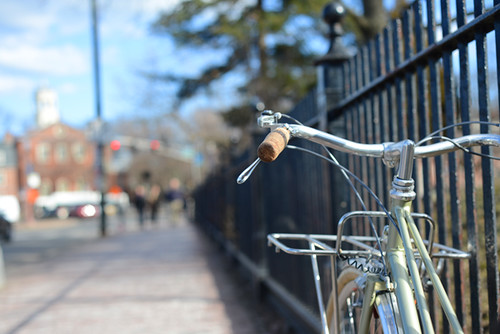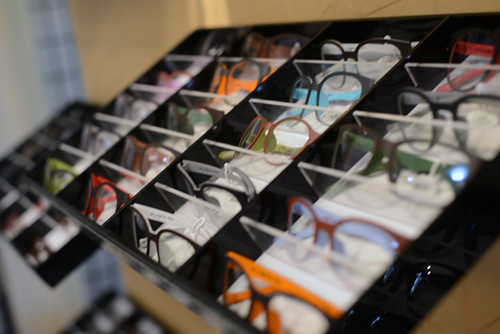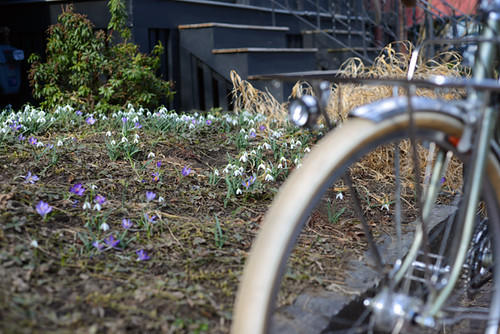Wednesday, September 15th - - After leaving the visitor center at Paradise late yesterday afternoon, I drove over to the southeast side of the Mount Rainier National Park and stayed at the campground at Ohanapecosh. I woke up early this morning and, in the hopes that the mountain would once again be out, decided to go to the Sunrise area on the northeast side, about an hours drive.
The campground was sheltered beneath a canopy of tall trees and it was hard to tell what the weather was really like. Leaving the campground I was disappointed to find the sky blanketed by gray clouds. But one thing I've learned about western Washington in my brief stay here is that just because the weather is lousy “here” doesn't mean it will be “there” too!

Half an hour after leaving the campground, I was ecstatic when I rounded a curve and there was Mt. Rainier! Rather gray in the early morning gloom, but there it was!

In the next 15 minutes, the mountain could be seen in several places and each vista presented a slightly different view. The road then went on the side away from Rainier and I could see that the sun would soon break through the clouds. The road twisted and turned and the going was agonizingly slow but after another 20 minutes I was at Sunrise Point.

From there on the views were absolutely stunning, especially whenever the sun decided to make an appearance.

A few minutes later, I was at the nearly empty parking lot of the Sunrise visitor center, which was closed for the season as was the Ranger Station. I strolled along one of the numerous trails, intending to walk for half an hour or so. But it was such a beautiful day and the mountain was mesmerizing. My short walk ended up being more than three hours long.

Looking north from the Sourdough Ridge Trail. (Double-click on this one to open the larger image - it's worth the extra clicks...)

Another view, looking north, from the Sourdough Ridge Trail.

The valley between Sourdough Ridge and Mt Rainier. The road is a gravel service road. There were workers out doing maintenance on some of the trails.

I walked to the other side of Burroughs Mountain (the ridge running in front of Mt Rainier). There was a trail that went up there with a view of Frozen Lake. I started up it but turned around after realizing it would take more time and energy than I could muster.

At times, the mountain seemed so close. Like I could reach out and touch it.

Why doesn't that snow fall? What is holding it up there? How deep is it?

To return to the parking lot, I took another trail, which went down into the valley. There weren't as many views of the mountain but the stillness and peacefulness were almost overwhelming.

Upon reaching the parking lot I decided to go down one more trail. A short one, less than half a mile round-trip, to Emmons Vista. Probably one of the most-photographed views of Rainier, just because it is so close to the visitors center.

Less than an hour later, you guessed it, the gray clouds had moved back in and the sun had taken its leave. And so did I.

 We got to the base and geared up for Big Tree. Rod led it and took a while completing the pitch. I had to run off into the woods before following. I joined him at the top of pitch one. We swapped the rack and I headed off on pitch two. Perhaps it is coming off the couch after a month of not climbing, but I didn't remember this pitch to be as run out. I got to the top and brought Rod over and he prepared for the next lead.
We got to the base and geared up for Big Tree. Rod led it and took a while completing the pitch. I had to run off into the woods before following. I joined him at the top of pitch one. We swapped the rack and I headed off on pitch two. Perhaps it is coming off the couch after a month of not climbing, but I didn't remember this pitch to be as run out. I got to the top and brought Rod over and he prepared for the next lead. Rod headed up the third (and best) pitch of the route. I had told him where I thought the crux was and he made good time heading up to it. At the crux he balked. He tried a higher gear placement and then even added a second cam. He down climbed a few steps and yo-yo'd a bit. He inspected holds and tried different options. After a long while, he confessed to me he did not have the moves in him. I lowered him down to the anchor and I switched to the sharp end to tackle the moves. The crux of the route in my opinion is a move where the lie backing ends and you have a few friction moves before picking up the lie backing again. I'm not sure it is the technical crux of the route, but it is the mental crux as you leave hand holds and counter pressure for some straight smearing.
Rod headed up the third (and best) pitch of the route. I had told him where I thought the crux was and he made good time heading up to it. At the crux he balked. He tried a higher gear placement and then even added a second cam. He down climbed a few steps and yo-yo'd a bit. He inspected holds and tried different options. After a long while, he confessed to me he did not have the moves in him. I lowered him down to the anchor and I switched to the sharp end to tackle the moves. The crux of the route in my opinion is a move where the lie backing ends and you have a few friction moves before picking up the lie backing again. I'm not sure it is the technical crux of the route, but it is the mental crux as you leave hand holds and counter pressure for some straight smearing. I climbed up the crux on top rope and then rearranged the gear Rod had placed so I could have more gear above the crux. I tried the moves and was attempting to remember how I did it last time, but I was not being successful. I couldn't commit to my right foot. I down climbed a few times to a ledge to rest my feet. Was I no longer capable of doing the moves? I had tried low, I had tried midway. What if I tried high? I started back up and instead of forcing my moves rightward I just followed the natural rhythm of the rock and found myself going up a bit more before rightward moves commenced. It felt good. The small tree that I had previously slung appeared bigger, but not as lively. I slung it again and headed off to finish the pitch.
I climbed up the crux on top rope and then rearranged the gear Rod had placed so I could have more gear above the crux. I tried the moves and was attempting to remember how I did it last time, but I was not being successful. I couldn't commit to my right foot. I down climbed a few times to a ledge to rest my feet. Was I no longer capable of doing the moves? I had tried low, I had tried midway. What if I tried high? I started back up and instead of forcing my moves rightward I just followed the natural rhythm of the rock and found myself going up a bit more before rightward moves commenced. It felt good. The small tree that I had previously slung appeared bigger, but not as lively. I slung it again and headed off to finish the pitch. Rod got the lead on Under the Bored Walk. A route I suggest to anyone who is climbing at Darrington for the first time. I had him lead it to the top in one pitch. I followed, experimenting with my approach shoes. This was quite scary at first, but as the difficulty eased and I got used to the feeling of chicken heads under my feet, it was not too bad. Afterward, Rod said the route was a good one to bring people new to rock climbing as it was fun and easy.
Rod got the lead on Under the Bored Walk. A route I suggest to anyone who is climbing at Darrington for the first time. I had him lead it to the top in one pitch. I followed, experimenting with my approach shoes. This was quite scary at first, but as the difficulty eased and I got used to the feeling of chicken heads under my feet, it was not too bad. Afterward, Rod said the route was a good one to bring people new to rock climbing as it was fun and easy.








 Half an hour after leaving the campground, I was ecstatic when I rounded a curve and there was Mt. Rainier! Rather gray in the early morning gloom, but there it was!
Half an hour after leaving the campground, I was ecstatic when I rounded a curve and there was Mt. Rainier! Rather gray in the early morning gloom, but there it was! In the next 15 minutes, the mountain could be seen in several places and each vista presented a slightly different view. The road then went on the side away from Rainier and I could see that the sun would soon break through the clouds. The road twisted and turned and the going was agonizingly slow but after another 20 minutes I was at Sunrise Point.
In the next 15 minutes, the mountain could be seen in several places and each vista presented a slightly different view. The road then went on the side away from Rainier and I could see that the sun would soon break through the clouds. The road twisted and turned and the going was agonizingly slow but after another 20 minutes I was at Sunrise Point. From there on the views were absolutely stunning, especially whenever the sun decided to make an appearance.
From there on the views were absolutely stunning, especially whenever the sun decided to make an appearance. A few minutes later, I was at the nearly empty parking lot of the Sunrise visitor center, which was closed for the season as was the Ranger Station. I strolled along one of the numerous trails, intending to walk for half an hour or so. But it was such a beautiful day and the mountain was mesmerizing. My short walk ended up being more than three hours long.
A few minutes later, I was at the nearly empty parking lot of the Sunrise visitor center, which was closed for the season as was the Ranger Station. I strolled along one of the numerous trails, intending to walk for half an hour or so. But it was such a beautiful day and the mountain was mesmerizing. My short walk ended up being more than three hours long. Looking north from the Sourdough Ridge Trail. (Double-click on this one to open the larger image - it's worth the extra clicks...)
Looking north from the Sourdough Ridge Trail. (Double-click on this one to open the larger image - it's worth the extra clicks...) Another view, looking north, from the Sourdough Ridge Trail.
Another view, looking north, from the Sourdough Ridge Trail. The valley between Sourdough Ridge and Mt Rainier. The road is a gravel service road. There were workers out doing maintenance on some of the trails.
The valley between Sourdough Ridge and Mt Rainier. The road is a gravel service road. There were workers out doing maintenance on some of the trails. I walked to the other side of Burroughs Mountain (the ridge running in front of Mt Rainier). There was a trail that went up there with a view of Frozen Lake. I started up it but turned around after realizing it would take more time and energy than I could muster.
I walked to the other side of Burroughs Mountain (the ridge running in front of Mt Rainier). There was a trail that went up there with a view of Frozen Lake. I started up it but turned around after realizing it would take more time and energy than I could muster. At times, the mountain seemed so close. Like I could reach out and touch it.
At times, the mountain seemed so close. Like I could reach out and touch it. Why doesn't that snow fall? What is holding it up there? How deep is it?
Why doesn't that snow fall? What is holding it up there? How deep is it? To return to the parking lot, I took another trail, which went down into the valley. There weren't as many views of the mountain but the stillness and peacefulness were almost overwhelming.
To return to the parking lot, I took another trail, which went down into the valley. There weren't as many views of the mountain but the stillness and peacefulness were almost overwhelming. Upon reaching the parking lot I decided to go down one more trail. A short one, less than half a mile round-trip, to Emmons Vista. Probably one of the most-photographed views of Rainier, just because it is so close to the visitors center.
Upon reaching the parking lot I decided to go down one more trail. A short one, less than half a mile round-trip, to Emmons Vista. Probably one of the most-photographed views of Rainier, just because it is so close to the visitors center. Less than an hour later, you guessed it, the gray clouds had moved back in and the sun had taken its leave. And so did I.
Less than an hour later, you guessed it, the gray clouds had moved back in and the sun had taken its leave. And so did I.






















